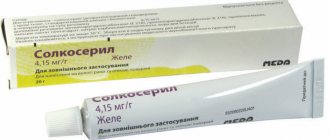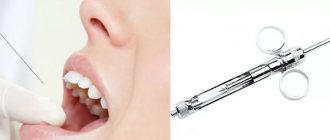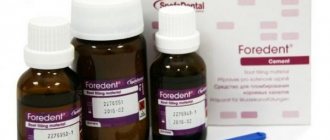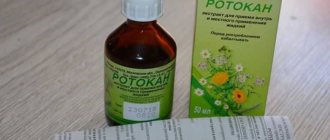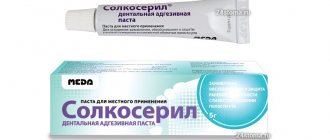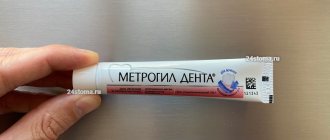pharmachologic effect
Ketorolac has a pronounced analgesic effect and also has anti-inflammatory and moderate antipyretic effects.
The mechanism of action is associated with non-selective inhibition of the activity of the enzyme cyclooxygenase 1 and 2, mainly in peripheral tissues, resulting in inhibition of the biosynthesis of prostaglandins - modulators of pain sensitivity, thermoregulation and inflammation.
Ketorolac is a racemic mixture of [-]S and [+]R enantiomers, and the analgesic effect is due to the [-]S form. The drug does not affect opioid receptors, does not depress respiration, does not cause drug dependence, and does not have a sedative or anxiolytic effect.
The strength of the analgesic effect is comparable to morphine, significantly superior to other non-steroidal anti-inflammatory drugs (NSAIDs).
After intramuscular administration, the onset of analgesic effect is noted after 0.5 hours, the maximum effect is achieved after 1-2 hours.
Release form
- Ketorolac tablets are white-coated, biconvex. 10 such tablets in contour packaging; 1,2, 5 or 10 packs in a paper pack. 10 such tablets in a polymer jar; one such jar in a pack of paper. 25 of these tablets in contour packaging; 2 or 4 packs in a paper pack.
- Ketorolac (i.v., i.m.) in ampoules contains a transparent solution of white-yellow color. 1 or 2 ml of this solution in an ampoule; 5 ampoules in contour packaging, 1 or 2 such packages in a cardboard box. 1 or 2 ml of this solution in an ampoule; 10 such ampoules in a cardboard box.
Pharmacokinetics
Absorption when administered intramuscularly is complete and rapid. After intramuscular administration of 30 mg of the drug, the maximum concentration in blood plasma (Cmax) is 1.74-3.1 μg/ml; 60 mg – 3.23-5.77 µg/ml, time to reach maximum concentration, respectively – 15-73 minutes and 30-60 minutes; the maximum concentration after intravenous infusion of 15 mg is 1.96-2.98 mcg/ml, 30 mg is 3.69-5.61 mcg/ml. The time to reach equilibrium concentration (Css) with parenteral administration is 24 hours when administered 4 times a day (above the subtherapeutic dose) and with intramuscular administration is 15 mg - 0.65-1.13 mcg/ml, 30 mg - 1.29- 2.47 mcg/ml, with intravenous infusion of 15 mg – 0.79-1.39 mcg/ml, 30 mg – 1.68-2.76 mcg/ml.
99.2% of the drug binds to blood plasma proteins and with hypoalbuminemia the amount of free substance in the blood increases.
The volume of distribution is 0.15-0.33 l/kg. In patients with renal failure, the volume of distribution of the drug may increase by 2 times, and the volume of distribution of its R-enantiomer by 20%. Poorly passes through the blood-brain barrier and penetrates the placenta (10%). Found in small quantities in breast milk.
More than 50% of the administered dose is metabolized in the liver with the formation of pharmacologically inactive metabolites. The main metabolites are glucuronides, which are excreted by the kidneys, and p-hydroxyketorolac, which is excreted 91% by the kidneys, 6% through the intestines.
The half-life (T1/2) in patients with normal renal function averages 5.3 hours (3.5-9.2 hours after intramuscular administration of 30 mg and 4-7.9 hours after intravenous administration of 30 mg). The half-life is prolonged in elderly patients and shortened in young patients. Liver function does not affect the half-life. In patients with impaired renal function with a plasma creatinine concentration of 19-50 mg/l (168-442 µmol/l), the half-life is 10.3-10.8 hours, with more severe renal failure - more than 13.6 hours.
The total clearance is with intramuscular administration of 30 mg - 0.023 l/kg/h (0.019 l/kg/h in elderly patients), intravenous administration of 30 mg - 0.03 l/kg/h; in patients with renal failure with a plasma creatinine concentration of 19-50 mg/l with intramuscular administration of 30 mg - 0.015 l/kg/h.
Not excreted during hemodialysis.
There is information about the effectiveness of the drug for migraine attacks.
Ketarolac price, where to buy
In Russia, the price of Ketorolac No. 10 ampoules is 99-101 rubles, the price of Ketorolac No. 20 tablets is approximately 18 rubles. In Ukraine, ampoules of drug No. 10 cost 54-75 hryvnia, tablets No. 10 cost 9-25 hryvnia.
- Online pharmacies in RussiaRussia
- Online pharmacies in UkraineUkraine
- Online pharmacies in KazakhstanKazakhstan
ZdravCity
- Ketorolac Welfarm solution for IV and IM injection 30 mg/ml amp.
1ml 10 pcs. Welfarm LLC 62 rub. order - Ketorolac tab. p.p.o. 10mg 20pcs JSC Tatkhimfarmpreparaty
35 rub. order
- Ketorolac solution for intravenous and intramuscular administration. 30mg/ml amp. 1ml 10 pcs. Biosynthesis JSC
69 RUR order
- Ketorolac-solopharm solution for intravenous and intramuscular injection 30 mg/ml (amp) 1 ml No. 10 Grotex LLC RU
86 rub. order
- Ketorolac solution for intravenous and intramuscular administration. 30mg/ml amp. 1ml 10 pcs. Ozone LLC
80 rub. order
Pharmacy Dialogue
- Ketorolac (amp. 30 mg/ml 1 ml No. 10) Sintez (Kurgan) OJSC
81 RUR order
- Ketorolac (amp. 30 mg/ml 1 ml 2x5 No. 10) Ellara LLC
51 RUR order
- Ketorolac (amp. 30 mg/ml 1 ml No. 10) Welfarm LLC
57 RUR order
- Ketorolac (tab.p.pl/vol. 10mg No. 28)Update of PFC CJSC
66 RUR order
- Ketorolac (amp. 30 mg/ml 1 ml No. 10) Biosynthesis OJSC
54 RUR order
show more
PaniPharmacy
- KETOROLAC ampoule Ketorolac r/r d/in.
3% 1ml. No. 10 Ukraine, Health LLC 99 UAH. order - KETOROLAC tablets Ketorolac tablets. 10mg No. 10 Ukraine, Health LLC
18 UAH order
show more
Contraindications
- hypersensitivity to ketorolac;
- complete or incomplete combination of bronchial asthma, recurrent polyposis of the nose or paranasal sinuses and intolerance to acetylsalicylic acid and other NSAIDs (including a history);
- erosive and ulcerative changes in the mucous membrane of the stomach and duodenum, active gastrointestinal bleeding; cerebrovascular or other bleeding;
- inflammatory bowel diseases (Crohn's disease, ulcerative colitis) in the acute phase;
- hemophilia and other bleeding disorders;
- decompensated heart failure;
- liver failure or active liver disease;
- severe renal failure (creatinine clearance less than 30 ml/min), progressive kidney disease, confirmed hyperkalemia;
— postoperative period after coronary artery bypass grafting;
- simultaneous use with probenecid, pentoxifylline, acetylsalicylic acid and other NSAIDs (including cyclooxygenase-2 inhibitors), lithium salts, anticoagulants (including warfarin and heparin);
— the drug is not used for prophylactic pain relief before and during major surgical interventions due to the high risk of bleeding;
- pregnancy, childbirth, lactation;
- children under 16 years of age (safety and effectiveness have not been established).
Carefully
Bronchial asthma, coronary heart disease, congestive heart failure, edema syndrome, arterial hypertension, cerebrovascular diseases, pathological dyslipidemia or hyperlipidemia, renal failure (creatinine clearance 30-60 ml/l), diabetes mellitus, cholestasis, sepsis, systemic lupus erythematosus, diseases peripheral arteries, smoking, old age (over 65 years), anamnestic data on the development of ulcerative lesions of the gastrointestinal tract, frequent alcohol consumption, severe somatic diseases, concomitant therapy with the following drugs: antiplatelet agents (for example, clopidogrel), oral glucocorticosteroids (for example, prednisolone ), selective serotonin reuptake inhibitors (eg, citalopram, fluoxetine, paroxetine, sertraline).
Use during pregnancy and breastfeeding
Use during pregnancy is contraindicated: adequate and strictly controlled studies have not been conducted in pregnant women.
During labor and delivery, the use of the drug is contraindicated, because By inhibiting the synthesis of prostaglandins, it can negatively affect the blood circulation of the fetus and weaken the contractile activity of the uterus, which increases the risk of uterine bleeding.
During treatment, breastfeeding should be stopped, since the drug, by inhibiting the synthesis of prostaglandins, can cause adverse effects in newborns.
special instructions
Before prescribing the drug, it is necessary to clarify the issue of a previous allergic reaction to the drug or NSAID. Due to the risk of allergic reactions, the first dose is administered under close medical supervision.
Hypovolemia increases the risk of nephrotoxic adverse reactions. If necessary, can be prescribed in combination with narcotic analgesics.
It is not recommended for use as a drug for prophylactic pain relief, before and during major surgical interventions due to the high risk of bleeding.
The drug should not be used together with NSAIDs (including cyclooxygenase-2 inhibitors), since when taken together with other NSAIDs, fluid retention, cardiac decompensation, and increased blood pressure may occur. The effect on platelet aggregation ceases after 24-48 hours.
The drug may change the properties of platelets.
Patients with blood coagulation disorders are prescribed only with constant monitoring of platelet counts, especially important for postoperative patients who require careful monitoring of hemostasis.
The risk of developing drug complications increases with lengthening of treatment (in patients with chronic pain) and increasing the dose of the drug to more than 90 mg/day. To reduce the risk of adverse events, the minimum effective dose should be used for the shortest possible short course.
Effect of the drug on the ability to drive vehicles and machinery
Since a significant proportion of patients who are prescribed ketorolac develop side effects from the central nervous system (drowsiness, dizziness, headache), it is recommended to avoid performing work that requires increased attention and quick reaction (driving a vehicle, working with machinery, etc.).
Directions for use and doses
The drug must be administered intravenously over at least 15 seconds (for dosage forms containing ethanol).
Intramuscularly administered slowly, deep into the muscle, in minimally effective doses, selected in accordance with the intensity of pain and the patient’s response. If necessary, additional opioid analgesics can be prescribed at the same time in reduced doses.
Single doses for a single intramuscular or intravenous administration:
- patients 16-64 years old with a body weight of more than 50 kg - 10-30 mg, depending on the severity of the pain syndrome;
- patients 16-64 years old with body weight less than 50 kg, patients over 65 years old or with impaired renal function - 10-15 mg.
Doses for repeated parenteral administration:
Intramuscular:
-patients 16-64 years old with a body weight of more than 50 kg are given 10-30 mg for the first injection, then 10-30 mg every 4-6 hours;
- with a body weight of less than 50 kg, patients over 65 years of age or with impaired renal function - 10-15 mg every 4-6 hours.
Intravenously:
-patients 16-64 years old with a body weight of more than 50 kg are injected with 10-30 mg, then 10-30 mg every 6 hours, with continuous infusion using an infusion pump, the initial dose is 30 mg, and then the infusion rate is 5 mg /hour;
-patients 16-64 years old with body weight less than 50 kg, patients over 65 years old or with impaired renal function are administered a bolus of 10-15 mg every 6 hours.
The maximum daily dose for patients 16-64 years old with a body weight of more than 50 kg should not exceed 90 mg, and for patients 16-64 years old with a body weight less than 50 kg, over 65 years old or with impaired renal function - 60 mg as for intramuscular, and intravenous routes of administration.
Continuous intravenous infusion should not last more than 24 hours.
When administered parenterally, the duration of treatment should not exceed 2 days.
When switching from parenteral administration of the drug to oral administration, the total daily dose of both dosage forms on the day of transfer should not exceed 90 mg for patients 16-64 years old with a body weight of more than 50 kg and 60 mg for patients 16-64 years old with a body weight less than 50 kg, over 65 years of age or with impaired renal function. In this case, the dose of the drug in tablets on the day of transition should not exceed 30 mg.
Analogs
Level 4 ATC code matches:
Voltaren
Rapten
Zerodol
Dickloberl Retard
Dikloberl N 75
Dicloberl
Ketanov
Dolak
Panoxen
Naklofen Duo
Naklofen
Olfen-100
Olfen-75
Neurodiclovit
Nizilat
Fanigan
Aertal
Methindol retard
Ortofen
Ketarolac analogues: Ketanov, Ketorol, Ketonort, Ketorolac-Credofarm and others.
Side effect
Often - 1-10%, infrequently - 0.1-1%, rarely - 0.01-0.1%, very rarely - less than 0.001%, including isolated cases.
From the digestive system:
often (especially in elderly patients over 65 years of age with a history of erosive and ulcerative lesions of the gastrointestinal tract) - gastralgia, diarrhea; infrequently – stomatitis, flatulence, constipation, vomiting, feeling of fullness of the stomach; rarely - nausea, erosive and ulcerative lesions of the gastrointestinal tract (including with perforation and/or bleeding - abdominal pain, spasm or burning in the epigastric region, blood in the stool or melena, vomiting with blood or coffee-like vomiting thick", nausea, heartburn, etc.), cholestatic jaundice, hepatitis, hepatomegaly, acute pancreatitis.
From the urinary system
: rarely - acute renal failure, lower back pain with or without hematuria and/or azotemia, hemolytic uremic syndrome (hemolytic anemia, renal failure, thrombocytopenia, purpura), frequent urination, increased or decreased urine volume, nephritis, edema of renal origin.
From the senses
: rarely - hearing loss, ringing in the ears, visual impairment (including blurred vision).
From the respiratory system
: rarely - bronchospasm or dyspnea, rhinitis, pulmonary edema, laryngeal edema (shortness of breath, difficulty breathing).
From the side of the central nervous system
: often – headache, dizziness, drowsiness; rarely - aseptic meningitis (fever, severe headache, convulsions, stiffness of the neck and/or back muscles), hyperactivity (mood changes, anxiety), hallucinations, depression, psychosis.
From the cardiovascular system
: uncommon – increased blood pressure, rare – pulmonary edema, fainting.
From the hematopoietic organs
: rarely – anemia, eosinophilia, leukopenia.
From the hemostasis system
: rarely - bleeding from a postoperative wound, nosebleeds, rectal bleeding.
From the skin
: uncommon – skin rash (including maculopapular rash), purpura, rare – exfoliative dermatitis (fever with or without chills, flushing, redness, thickening or peeling of the skin, swelling and/or tenderness of the tonsils), urticaria, erythema malignant exudative (Stevens syndrome - Johnson), toxic epidermal necrolysis (Lyell's syndrome).
Local reactions
: uncommon – burning or pain at the injection site.
Allergic reactions
: rarely - anaphylaxis or anaphylactoid reactions (change in facial skin color, skin rash, urticaria, skin itching, tachypnea or dyspnea, swelling of the eyelids, periorbital edema, shortness of breath, difficulty breathing, heaviness in the chest, wheezing).
Others
: often - swelling (of the face, legs, ankles, fingers, feet), weight gain, infrequently - increased sweating, rarely - swelling of the tongue, fever.
Overdose
Symptoms: abdominal pain, nausea, vomiting, peptic ulcers or erosive gastritis, impaired renal function, metabolic acidosis.
Treatment: symptomatic therapy (maintaining vital functions in the body). Not eliminated sufficiently by dialysis.
Ketorolac solution d/iv and intramuscular injection 30 mg/ml 1 ml No. 10
Compound
Active substance: ketorolac trometamol (ketorolac tromethamine) - 30 mg. Excipients: ethanol 95% (in terms of 100% substance) - 100 mg, sodium chloride - 4.35 mg, hydrochloric acid solution 1M or sodium hydroxide solution 1M - to pH 6.9-7.9, water for injection - up to 1 ml.
Pharmacokinetics
When taken orally, ketorolac is well absorbed from the gastrointestinal tract. Bioavailability is 80-100%. Cmax in blood plasma is 0.7-1.1 mcg/ml and is achieved 40 minutes after taking the drug on an empty stomach at a dose of 10 mg. Food rich in fat reduces the Cmax of the drug in the blood and delays its achievement by 1 hour.
With intramuscular administration, absorption is complete and rapid. After intramuscular administration of the drug at a dose of 30 mg, Cmax in blood plasma is 1.74-3.1 mcg/ml, at a dose of 60 mg - 3.23-5.77 mcg/ml. Tmax is respectively 15-73 min and 30-60 min.
After an intravenous infusion of the drug at a dose of 15 mg, Cmax is 1.96-2.98 mcg/ml, at a dose of 30 mg - 3.69-5.61 mcg/ml.
Plasma protein binding - 99%. With hypoalbuminemia, the amount of free substance in the blood increases.
Vd is 0.15-0.33 l/kg.
The time to reach Css when taken orally is 24 hours when used 4 times a day (above subtherapeutic). Css after oral administration at a dose of 10 mg is 0.39-0.79 mcg/ml.
Css with parenteral administration is achieved after 24 hours when used 4 times a day (above subtherapeutic) and with IM administration at a dose of 15 mg is 0.65-1.13 mcg/ml, with IM administration at a dose of 30 mg - 1.29-2.47 mcg /ml; with an intravenous infusion at a dose of 15 mg - 0.79-1.39 mcg/ml, with an intravenous infusion at a dose of 30 mg - 1.68-2.76 mcg/ml.
Poorly passes through the BBB, penetrates the placental barrier (10%).
Excreted in breast milk: when the mother takes 10 mg of ketorolac orally, Cmax in breast milk is achieved 2 hours after taking the first dose and is 7.3 ng/ml, 2 hours after taking the second dose of ketorolac (when using the drug 4 times a day) Cmax is 7.9 ng/ml.
When administered parenterally, it is excreted in breast milk in small quantities.
More than 50% of the administered dose is metabolized in the liver with the formation of pharmacologically inactive metabolites. The main metabolites are glucuronides and p-hydroxyketorolac.
Excreted in urine - 91% (40% in the form of metabolites), in feces - 6%. Not excreted by hemodialysis.
After oral administration, T1/2 in patients with normal renal function is 2.4-9 hours (average 5.3 hours).
After intramuscular administration of 30 mg T1/2 - 3.5-9.2 hours, after intravenous administration of 30 mg T1/2 - 4-7.9 hours.
The total clearance with intramuscular injection of 30 mg is 0.023 l/kg/h, with intravenous infusion of 30 mg - 0.03 l/kg/h.
In patients with renal failure, the Vd of the drug may increase by 2 times, and the Vd of its R-enantiomer by 20%. With a plasma creatinine concentration of 19-50 mg/l with intramuscular administration of 30 mg of the drug, the total clearance is 0.015 l/kg/h.
In patients with impaired renal function with a plasma creatinine concentration of 19-50 mg/l (168-442 µmol/l), T1/2 is 10.3-10.8 hours, with more severe renal failure - more than 13.6 hours.
Liver function has no effect on T1/2.
In elderly patients, the total clearance when administered intramuscularly at a dose of 30 mg is 0.019 l/kg/h. T1/2 lengthens in elderly patients and shortens in young ones.
Indications for use
Pain syndrome of severe and moderate severity: injuries, toothache, pain in the postoperative period, cancer, myalgia, arthralgia, neuralgia, radiculitis, dislocations, sprains, rheumatic diseases.
Intended for symptomatic therapy, reducing pain and inflammation at the time of use, does not affect the progression of the disease.
Contraindications
Hypersensitivity to ketorolac or to other components of the drug, complete or incomplete combination of bronchial asthma, recurrent polyposis of the nose and paranasal sinuses, intolerance to acetylsalicylic acid or other non-steroidal anti-inflammatory drugs (including a history), urticaria, rhinitis caused by taking non-steroidal anti-inflammatory drugs medications (history), dehydration.
Intolerance to pyrazolone-type drugs, hypovolemia (regardless of the cause), bleeding or a high risk of its development, condition after coronary artery bypass surgery, confirmed hyperkalemia, inflammatory bowel diseases.
Erosive and ulcerative lesions of the gastrointestinal tract in the acute stage, peptic ulcers, hypocoagulation (including hemophilia).
Severe liver and/or renal failure (creatinine clearance less than 30 ml/min).
Hemorrhagic stroke (confirmed or suspected), hemorrhagic diathesis, hematopoiesis disorder, intracranial hemorrhage or suspicion of it.
Concomitant use with probenecid, pentoxifylline, acetylsalicylic acid and other NSAIDs (including cyclooxygenase-2 inhibitors), lithium salts, anticoagulants, including warfarin and heparin is not recommended.
Pregnancy, childbirth and breastfeeding.
Children under 16 years of age (safety and effectiveness of use have not been established).
The drug is not used for pain relief before and during surgery due to the high risk of bleeding, as well as for the treatment of chronic pain.
Directions for use and doses
Intravenously, intramuscularly.
Injected deep into the muscle, slowly (or intravenously in a stream) for at least 15 seconds in the minimum effective doses, in a minimally short course.
Single doses for a single intramuscular or intravenous administration:
- adults under 65 years of age and children over 16 years of age - 10-30 mg, depending on the severity of the pain syndrome;
- adults over 65 years of age or with impaired renal function - 10-15 mg.
Doses for repeated parenteral administration:
intramuscularly
- adults under 65 years of age and children over 16 years of age are given 10-60 mg (0.3-2 ml) for the first injection, then 10-30 mg (0.3-1 ml) every 6 hours (usually 30 mg ( 1 ml) every 6 hours);
- adults over 65 years of age or with impaired renal function - 10-15 mg (0.3-0.5 ml) every 4-6 hours.
intravenously
- adults under 65 years of age and children over 16 years of age are injected with 10-30 mg (0.3-1 ml), then 10-30 mg (0.3-1 ml) every 6 hours, with continuous infusion using an infusion pump the initial dose is 30 mg (1 ml), and then the infusion rate is 5 mg/h;
- adults over 65 years of age or with impaired renal function are given a bolus of 10-15 mg (0.3-0.5 ml) every 6 hours.
The maximum daily dose for adults under 65 years of age and children over 16 years of age should not exceed 90 mg (3 ml), and for adults over 65 years of age or with impaired renal function - 60 mg (2 ml) for both intramuscular and intravenous routes of administration .
Continuous intravenous infusion should not last more than 24 hours.
The maximum duration of treatment should not exceed 2 days.
When switching from parenteral administration of the drug to oral administration, the total daily dose of both dosage forms on the day of transfer should not exceed 90 mg for adults under 65 years of age and children over 16 years of age and 60 mg for adults over 65 years of age or with impaired renal function. In this case, the dose of the drug in tablets on the day of transition should not exceed 30 mg.
Storage conditions
In a place protected from light, at a temperature not exceeding 25 ° C. Do not freeze.
Keep out of the reach of children.
Best before date
3 years. Do not use after expiration date.
special instructions
- When used together with other NSAIDs, fluid retention, cardiac decompensation, and arterial hypertension may occur.
- To reduce the risk of developing NSAID gastropathy, antacids, misoprostol, and omeprazole are prescribed.
- The effect on platelet aggregation lasts for 24-48 hours.
- Hypovolemia increases the risk of developing adverse reactions from the kidneys.
- If necessary, can be prescribed in combination with opioid analgesics.
- Do not use simultaneously with paracetamol for more than 5 days.
- In patients with blood coagulation disorders, it is used only with constant monitoring of the platelet count, especially in the postoperative period, which requires careful monitoring of hemostasis.
Description
NSAIDs with a pronounced analgesic effect.
Dosage form
Solution for intravenous and intramuscular administration in the form of a clear, light yellow liquid.
Use in children
Contraindication: children and adolescents under 16 years of age (efficacy and safety have not been established).
Pharmacodynamics
NSAIDs have a pronounced analgesic (pain-relieving) effect, and also have anti-inflammatory and moderate antipyretic effects.
The mechanism of action is associated with non-selective inhibition of the activity of the enzymes COX-1 and COX-2, mainly in peripheral tissues, resulting in inhibition of the biosynthesis of prostaglandins - modulators of pain sensitivity, inflammation and thermoregulation. Ketorolac is a racemic mixture of R(+) and S(-)-enantiomers, with the analgesic (pain-relieving) effect due to the S(-)-enantiomer.
Ketorolac does not affect opioid receptors, does not depress respiration, does not cause drug dependence, and does not have a sedative or anxiolytic effect.
The strength of the analgesic (pain-relieving) effect is comparable to morphine and significantly superior to other NSAIDs.
After oral administration, the onset of analgesic (pain-relieving) effect is observed after 1 hour, the maximum effect is achieved after 2-3 hours.
After intramuscular administration, the onset of analgesic (pain-relieving) effect is noted after 0.5 hours, the maximum effect is achieved after 1-2 hours.
Side effects
From the digestive system: often (especially in elderly patients over 65 years of age with a history of erosive and ulcerative lesions of the gastrointestinal tract) - gastralgia, diarrhea; less often - stomatitis, flatulence, constipation, vomiting, feeling of fullness in the stomach; rarely - loss of appetite, nausea, erosive and ulcerative lesions of the gastrointestinal tract (including with perforation and/or bleeding - abdominal pain, spasm or burning in the epigastric region, melena, vomiting with blood or coffee grounds, nausea, heartburn), cholestatic jaundice, hepatitis, hepatomegaly, acute pancreatitis.
From the urinary system: rarely - acute renal failure, lower back pain, hematuria, azotemia, hemolytic-uremic syndrome (hemolytic anemia, renal failure, thrombocytopenia, purpura), frequent urination, increased or decreased urine volume, nephritis, edema of renal origin.
From the nervous system: often - headache, dizziness, drowsiness; rarely - aseptic meningitis (including fever, severe headache, convulsions, stiffness of the neck and/or back muscles), hyperactivity (including mood changes, anxiety), hallucinations, depression, psychosis.
From the cardiovascular system: less often - increased blood pressure; rarely - fainting.
From the respiratory system: rarely - bronchospasm, dyspnea, rhinitis, pulmonary edema, laryngeal edema (including shortness of breath, difficulty breathing).
From the senses: rarely - hearing loss, ringing in the ears, visual impairment (including blurred visual perception).
From the hematopoietic system: rarely - anemia, eosinophilia, leukopenia.
From the blood coagulation system: rarely - bleeding from a postoperative wound, nosebleeds, rectal bleeding.
From the skin: less often - skin rash (including maculopapular), purpura; rarely - exfoliative dermatitis (including fever with or without chills, redness, thickening or flaking of the skin, swelling and/or tenderness of the tonsils), urticaria, Stevens-Johnson syndrome, Lyell's syndrome.
Allergic reactions: rarely - anaphylaxis or anaphylactoid reactions (including discoloration of the facial skin, skin rash, urticaria, itching of the skin, tachypnea or dyspnea, swelling of the eyelids, periorbital edema, shortness of breath, difficulty breathing, heaviness in the chest, wheezing ).
Local reactions: less often - burning or pain at the injection site.
Other: often - swelling (including of the face, legs, ankles, fingers, feet), weight gain; less often - increased sweating; rarely - swelling of the tongue, fever.
Use during pregnancy and breastfeeding
The use of the drug is contraindicated during pregnancy, during childbirth and during breastfeeding.
Interaction
- The simultaneous use of ketorolac with acetylsalicylic acid or other NSAIDs, calcium preparations, corticosteroids, ethanol, corticotropin can lead to the formation of gastrointestinal ulcers and the development of gastrointestinal bleeding.
- Co-administration with paracetamol increases nephrotoxicity, and with methotrexate - hepato- and nephrotoxicity.
- Co-administration of ketorolac and methotrexate is possible only when using low doses of the latter (monitor the concentration of methotrexate in the blood plasma).
- With the use of ketorolac, the clearance of methotrexate and lithium may decrease and the toxicity of these substances may increase.
- Co-administration with indirect anticoagulants, heparin, thrombolytics, antiplatelet agents, cefoperazone, cefotetan and pentoxifylline increases the risk of bleeding.
- Reduces the effect of antihypertensive and diuretic drugs (the synthesis of prostaglandins in the kidneys decreases).
- When used simultaneously with opioid analgesics, the doses of the latter can be significantly reduced, because their effect is enhanced.
- When used simultaneously, it enhances the hypoglycemic effect of insulin and oral hypoglycemic drugs (dose recalculation is necessary).
- Co-administration with valproic acid causes disruption of platelet aggregation.
- Increases the plasma concentration of verapamil and nifedipine.
- When prescribed with other nephrotoxic drugs (including gold preparations), the risk of developing nephrotoxicity increases.
- Probenecid and drugs that block tubular secretion reduce the clearance of ketorolac and increase its concentration in the blood plasma.
- Myelotoxic drugs increase the manifestations of hematotoxicity of the drug.
- Pharmaceutically incompatible with tramadol solution and lithium preparations.
Overdose
Symptoms: abdominal pain, nausea, vomiting, erosive and ulcerative lesions of the gastrointestinal tract, impaired renal function, metabolic acidosis.
Treatment: there is no specific antidote; gastric lavage, administration of adsorbents (activated carbon) and symptomatic therapy (maintaining vital body functions) are recommended. Ketorolac is not sufficiently eliminated by dialysis.
Impact on the ability to drive vehicles and operate machinery
Since a significant proportion of patients using ketorolac develop side effects from the central nervous system (drowsiness, dizziness, headache), it is recommended to avoid performing work that requires increased attention and quick reaction (driving vehicles, working with machinery).
Interaction with other drugs
The simultaneous use of ketorolac with acetylsalicylic acid or other NSAIDs, including cyclooxygenase-2 inhibitors, calcium preparations, glucocorticosteroids, ethanol, corticotropin can lead to the formation of gastrointestinal ulcers and the development of gastrointestinal bleeding.
The drug should not be used simultaneously with other NSAIDs (including cyclooxygenase-2 inhibitors), as well as simultaneously with probenecid, pentoxifylline, acetylsalicylic acid, lithium salts, anticoagulants (including warfarin and heparin).
Do not use with paracetamol for more than 2 days. Co-administration with paracetamol increases nephrotoxicity, and with methotrexate - hepato- and nephrotoxicity. Co-administration of ketorolac and methotrexate is possible only when using low doses of the latter (monitor the concentration of methotrexate in the blood plasma).
Probenecid reduces the plasma clearance and volume of distribution of ketorolac, increases its concentration in the blood plasma and increases its half-life. With the use of ketorolac, the clearance of methotrexate and lithium may decrease and the toxicity of these substances may increase.
Co-administration with indirect coagulants (for example, warfarin), heparin, thrombolytics, antiplatelet agents, cefoperazone, cefotetan and pentoxifylline increases the risk of bleeding.
Reduces the effect of antihypertensive and diuretic drugs (the synthesis of prostaglandins in the kidneys is reduced). When combined with narcotic analgesics, the doses of the latter can be significantly reduced.
Antacids do not affect the complete absorption of the drug.
The hypoglycemic effect of insulin and oral hypoglycemic drugs increases (dose recalculation is necessary).
Co-administration with valproic acid causes disruption of platelet aggregation. Increases the plasma concentration of verapamil and nifedipine.
When prescribed with other nephrotoxic drugs (including gold preparations), the risk of developing nephrotoxicity increases.
Drugs that block tubular secretion reduce the clearance of ketorolac and increase its concentration in the blood plasma.
It is necessary to take into account possible interactions when using ketorolac simultaneously with cyclosporine, zidovudine, digoxin, tacrolimus, quinoline drugs, selective serotonin reuptake inhibitors, and mifepristone.

